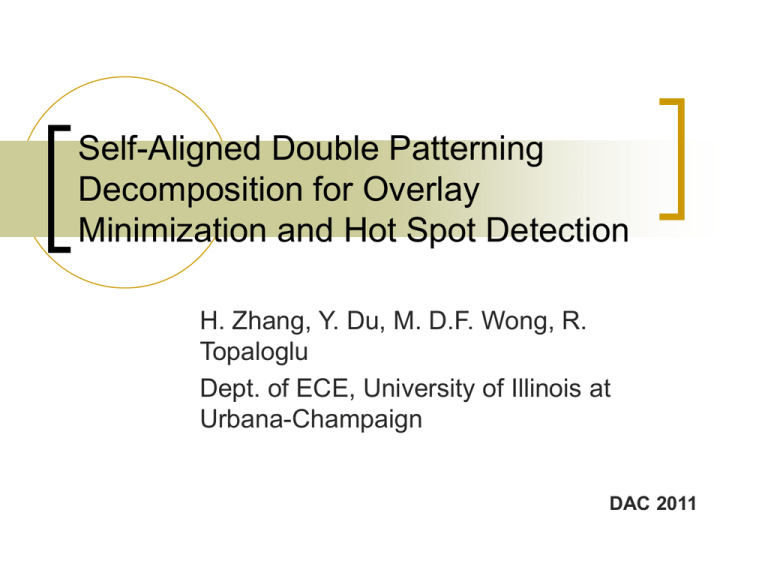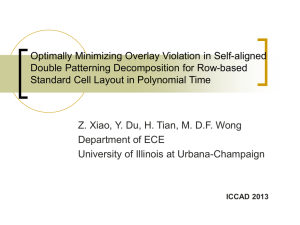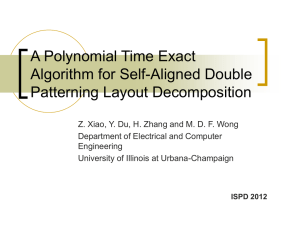PPT
advertisement

Self-Aligned Double Patterning
Decomposition for Overlay
Minimization and Hot Spot Detection
H. Zhang, Y. Du, M. D.F. Wong, R.
Topaloglu
Dept. of ECE, University of Illinois at
Urbana-Champaign
DAC 2011
Outline
Introduction
Overview of 2D SADP Process
Layout Decomposition Problem Formulation
Problem Reduction
Experimental Results
Conclusions
Introduction
Double patterning lithography (DPL) is the enabling
technology for printing in sub-32nm nodes
DPL technologies can be classified into two major
types:
Double-exposure double-patterning (DEDP)
Single-exposure double-patterning (SEDP)
Self-aligned double patterning (SADP)
Introduction
In SADP process, given a target layout, before the
manufacturing, core mask and trim mask must be
generated from the intended target layout.
Unlike the DEDP, the core mask and trim mask are
not always directly from the original layout.
The problem of generating the core and trim mask
from a 2D designed layout is called SADP
decomposition.
Introduction
Overview of 2D SADP Process
Layout Decomposition
Problem Formulation
Feature Generation and ILP formulation
Layout Decomposition
Problem Formulation
Feature and non-feature region constraint:
Feature is true if and only if this location has trim
mask and no side-wall.
Non-feature region:
Layout Decomposition
Problem Formulation
Core and trim mask geometry constraints:
Sidewall adjacency rule:
Si is 1 if and only if Ci is 0, among the core variables{Cj,
Cj+1,…,Cj+m} within the sidewall width distance, there is at
least one variable equal to 1.
Layout Decomposition
Problem Formulation
Minimum corner-corner rule:
If Ci is 1, Ci+1 is 0 and Ci+2 is 0, then all variables {Ck,
Ck+1, …, Ck+q} within the minimum corner-corner distance
should be 0.
Layout Decomposition
Problem Formulation
Minimum space rule:
If Ci is 1 and Ci+1 is 0, then all variables {Ci+2, Ci+3, …,
Ci+p} within the minimum space distance should be 0.
Layout Decomposition
Problem Formulation
Minimum width rule:
If Ci is 0 and Ci+1 is 1, then all variables {Ci+2, Ci+3, …,
Ci+n} within the minimum width distance should be 1.
Layout Decomposition
Problem Formulation
Objective for Overlay Minimization
The most critical target for the layout decomposition is to
minimize the total overlay, in other words, to maximize the
non-overlay boundaries’ length.
Non-overlay boundary should be guarded by sidewalls,
and the trim mask will overlap with the sidewalls for at
least length W0.
The summation of all the trim variables within distance W0
of any feature to be B.
Layout Decomposition
Problem Formulation
Decomposability Check and Hotspot Detection
By finding the minimum conflicting constraint set, we can
perform hot spot detection.
Inserting extra binary slack variables onto each constraint.
Minimize the summation of the slack variable will be equal
to finding the minimum number of conflicting constraints.
Problem Reduction
Feature Region Variable Reduction
In one single feature, the trim variable will
always be 1, and the sidewall variable will be 0.
Combine core variables in one continuous
feature.
Problem Reduction
Core and Sidewall Variable Reduction
Problem Reduction
Core and Sidewall Variable Reduction
Only need to assign variables on the regions which are
within distance 2Ws+Wc,min.
Problem Reduction
Trim Variable Reduction
Experimental Results
Experimental Results
Experimental Results
Conclusions
This paper has finished the SADP decomposition
process with overlay minimization and hot spot
detection.
For a decomposable layout, this algorithm
guarantees to find a decomposable solution that
minimizes overlay.











